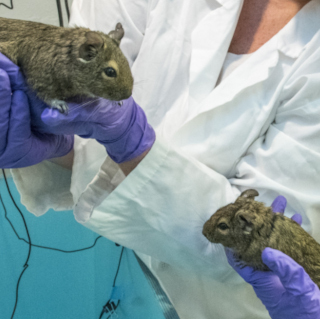Open-Drop Isoflurane Anesthesia
Last Date Reviewed: August 24, 2020
I. Purpose and Scope
The purpose of this Standard Operating Procedure (SOP) is to outline the use of open-drop Isoflurane anesthesia in rodents and birds in field studies. This anesthetic method will provide approximately 30 seconds of deep anesthesia during which rapid procedures, such as blood collection and tail biopsies may be accomplished in the field.
II. Policy
It is LAR policy to meet or exceed all federal, state, and local regulations and guidelines and to comply with all institutional policies and procedures as they apply to the use of animals in research. Personnel must attend any applicable training in animal care and use, occupational health and safety, equipment operation, and SOPs prior to performing activities outlined in this SOP or work under the direct supervision of trained personnel.
III. Procedures
A. Materials
1. Isoflurane
2. Cotton gauze pad
3. Tea strainer or conical tube with pre-drilled holes
4. Bell jar or wide-mouth glass container (with known volume). Any type of
container with a secure lid may be used, provided it is constructed of
of
B. Anesthetic Induction
1. Caution: This anesthetic induction method must be performed in an area with
good ventilation. If performed in a temporary field station – open two sides of the
wall tent for air circulation.
2. Don nitrile gloves and moisten the cotton pad (e.g., nestlet, gauze) with the 0.5 cc
of isoflurane per 500 cc volume of the anesthesia jar.
3. Place the cotton pad inside a small container (metal tea strainer). The use of the
tea strainer ensures that the animal does not contact the isoflurane-soaked pad,
which can cause skin irritation and potential overdosing since isoflurane is also
absorbed through the skin.
4. Transfer the animal to anesthesia jar and close lid tightly. Within approximately 15-
30 seconds the animal will become anesthetized. Initially, the respiratory rate will
increase and then decrease. Clinical indications of a deep plane of anesthesia in
rodents include the lack of a righting reflex (tip the jar gently) and a 50% reduction
in respiratory rate compared to pre- anesthesia levels.
5. Allow the animal to remain at a deep anesthetic plane for ~10 seconds before
proceeding. Quickly, yet carefully, remove the animal from the jar and place it on
a clean work surface. Replace the lid on the jar immediately.
6. Apply a noxious stimulus (i.e., toe pinch) to ensure adequate plane of anesthesia. If
no response is noted, the procedure can be initiated. If the animal responds to
noxious stimulus, return it to the jar and monitor respiratory rate as previously
performed.
7. The animal will remain deeply anesthetized for approximately 30 seconds following
exposure to the isoflurane in the induction chamber.
8. If the animal reaches a lighter plane of anesthesia during the procedure,
evidenced by increased respiratory rate, or purposeful movement, stop the
procedure and transfer the animal back to the bell jar, until the animal again
reaches a deep plane of anesthesia.
9. Allow the animal to recover on a piece of clean paper towel in a bedding-free
cage. Monitor the animal closely until it is fully recovered.
10. Close constant monitoring of animals is essential during induction and anesthesia
maintenance.
11. Re-wet the cotton pad with Isoflurane as needed.
